1. Toothbrush embroidery (also known as vertical thread embroidery) is a three-dimensional pattern layer woven from embroidery threads that are higher than the base fabric at a certain height. The embroidery threads are neat, vertical, and firm, similar to the effect of a toothbrush. It has been widely used in clothing, home accessories, handicrafts, and other fields. Toothbrush embroidery is a common embroidery process where a certain height of auxiliary material (such as three-dimensional glue) is added to the fabric. After embroidery is completed, the embroidery thread on the auxiliary material is repaired and leveled using a cutting machine or other cutting tools, and then the auxiliary material is removed to create a vertical and preset length embroidery thread, forming a three-dimensional embroidery pattern with a certain height of the toothbrush shape. The bottom of the embroidered pattern is ironed with hot glue to prevent the embroidery thread from loosening after processing.
Currently, toothbrush embroidery is generally produced using ordinary computer embroidery machines. The effect obtained after embroidery processing on the front of the fabric is front toothbrush embroidery. Due to the dry knot between the upper thread and the lower thread, the embroidery thread appears messy, affecting the appearance and product quality. On the contrary, reverse toothbrush embroidery achieves a processing effect by reversing the fabric and embroidering it on the back. The effect of reverse embroidery is that the embroidery thread will stand upright and neat, but due to the downward embroidery surface, the embroidery effect cannot be observed during the embroidery process. At the same time, friction between the embroidery thread and the tabletop also affects the quality of the embroidery product. Reverse embroidery is not conducive to mixed embroidery with multiple embroidery methods and is usually only used in situations where only toothbrush embroidery is used. To achieve mixed embroidery, it is necessary to reverse the fabric already embroidered with the toothbrush and then perform other types of embroidery separately. In fact, currently most toothbrush embroidery produced using ordinary embroidery machines is still reverse embroidery.
3. With people’s continuous pursuit of a better life, toothbrush embroidery is increasingly being widely used in various fields and showing more diverse and colorful products. The existing production technology of toothbrush embroidery seriously affects its production efficiency and product quality, is not conducive to reducing costs, and does not meet the requirements of high-quality development.
Post time: Jan-23-2024


